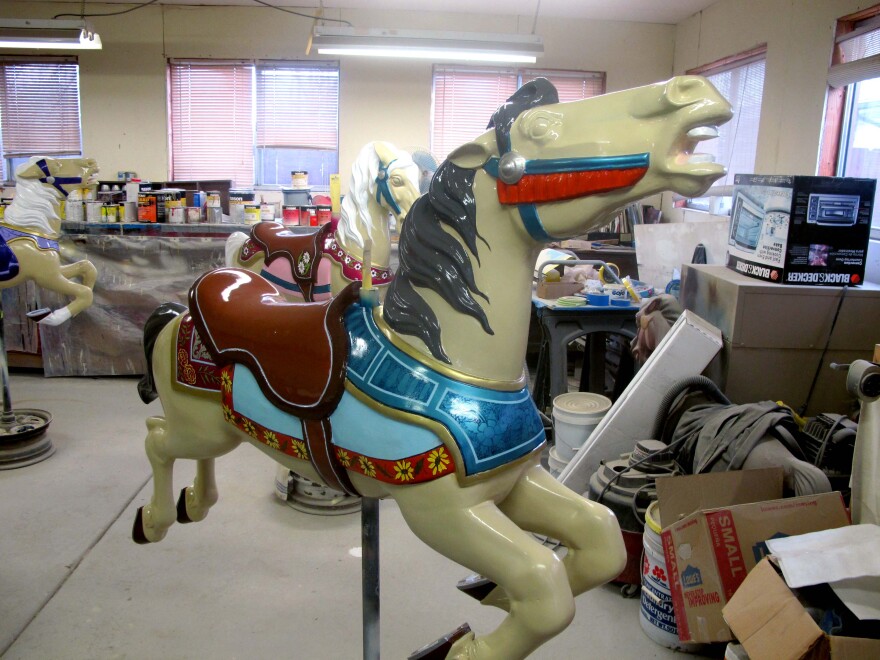Artist Marlene Irvin is busy these days restoring all 36 of Joyland’s carousel horses in her backyard workshop in Wichita. Next year, the horses will be installed in their new home at Botanica.
"Anybody that's lived in Wichita knows about Joyland and the carousel," Irvin says.

Margaret Nelson Spear, owner of the former Joyland Amusement Park, which closed in 2006, donated the carousel to Botanica. Irvin was hired to restore the horses and help with the restoration of the carousel that will be the center point of Botanica's gardens, she says.
Of the 36 horses, Irvin says she's so far completed 13, with four more close to completion -- and just one horse can take her up to 500 hours.
Below are highlights from her conversation with Carla Eckels. You can hear the full piece at the audio link above.
On the horses themselves:

These are what were called "half and halves." The bodies are wood, but they started making the legs and the tail and the head out of aluminum because the kids getting on and off tended to put their feet on the hooves and they would break the legs off. The tails used to be real horse tail. And after 10,000 pats and everything from the kids, they were just falling apart. So these were considered a more durable horse.
They started making these in the mid '30s, and then they stopped during World War II because the war effort needed all the aluminum. And so they went back to all wood and then after the war, they went back to half and halves for a very short amount of time and then they went to total aluminum carousel horses. So this pretty well dates the ride.
On the history of the carousel:
The carousel was purchased in October of 1949. So this was probably made for Joyland specifically because this was a little bit different. It was a 40-foot carousel, and most of them were 36 [feet].

The restoration process:
There might be anywhere between 10 to 50 coats of paint. I take all that paint down and strip it down to the bare wood and the bare metal. Then I repair all the cracks and all the splits and all the damaged wood. There's usually dry rot, and, I mean, we're talking 80-year-old wood. [It's] getting kind of old. It's got its problems. I get it, prime it, then I body-paint the whole thing the body color. Then I paint the basic blanket colors and then I do the design work and then all of this is done by hand with the brush. I've probably painted thousands of these horses and there's not one that is the same because it all comes out of my head and I do the design work and it's a one of a kind.
Since this is going into the botanical gardens, they said [they] want a more natural theme. Butterflies, birds and flowers to fit with its location.
How she got started as an artist:
People have asked me that question, and I can say that my talent was God-given and it’s 99 percent perspiration. I didn’t go to college or get any kind of degree, but it was just the talent that I had and then just practice, practice, and trial and error. I’ve painted a lot of stuff that looked bad. I’d have to take it off [and say,] "You look bad. I thought you were a good idea but you stink."

This is a unique job. You don't find too many people that do this. In fact, there are probably less than six here in the United States that do it professionally. Anybody can take it out in their garage and bang and ding, but the ones that really know what they are doing, there’s probably less than six.
On why she does this work:
I love it. It's it's my artistic expression. I've done it for years. I've done other pieces of antique art, band organ figures in band organ fronts. It's just such a unique thing and [people] say, "Well, don't you get tired of doing these horses?" Every one is different. They have different problems; they have different personalities.
I know that sounds funny but they speak to me. I mean, you can imagine you spent 300 hours with something, it's like you get to know it. It becomes a personality for me. It tells me whether it's male or female. It tells me whether it wants to be painted with masculine colors or feminine colors, it really does. And over these 40 years I've learned to listen, and they tell me what they want.
Read The Wichita Eagle's Feature On The City's Chances At Opening Another Amusement Park.
--
Carla Eckels is assistant news director and the host of Soulsations. Follow her on Twitter @Eckels.
To contact KMUW News or to send in a news tip, reach us at news@kmuw.org.



